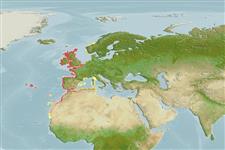Actinopterygii (ray-finned fishes) >
Perciformes (Perch-likes) >
Blenniidae (Combtooth blennies) > Salariinae
Etymology: Lipophrys: Greek, lipos = fat + Greek, ophrys = eyebow (Ref. 45335).
Environment / Climate / Range
Ecology
Marine; demersal; non-migratory; depth range 0 - 8 m (Ref. 5981). Temperate, preferred ?; 65°N - 18°N, 32°W - 11°E
Eastern Atlantic: southern Norway to Morocco and Madeira, including the Mediterranean and the Balearics.
Length at first maturity / Size / Weight / Age
Maturity: Lm 8.0 range ? - ? cm
Max length : 5.5 cm TL male/unsexed; (Ref. 41096); max. reported age: 10 years (Ref. 35388)
A resident intertidal species with homing behavior (Ref. 32612) found in shallow waters of rocky coasts. May remain out of water under rocks or seaweeds (Ref. 31184). Mostly active at daytime during high tide. Breathes air when out of water (Ref. 31184). Feeds on small benthic invertebrates, especially gastropods, barnacles and amphipods, and algae (Ref. 31184). Also, diet of crabs, polychaetes, isopods, copepods, limpets, mussels and small molluscs (Ref. 94105). Oviparous (Ref. 205). Eggs measuring 1.5 mm (Ref. 35388) are demersal and adhesive (Ref. 205). Spawning takes place in April - August (Ref. 35388).
Oviparous, distinct pairing (Ref. 205). Male guards eggs from several females (Ref. 5981).
Zander, C.D., 1986. Blenniidae. p. 1096-1112. In P.J.P. Whitehead, M.-L. Bauchot, J.-C. Hureau, J. Nielsen and E. Tortonese (eds.) Fishes of the North-eastern Atlantic and the Mediterranean, volume 3. UNESCO, Paris. (Ref. 5981)
IUCN Red List Status (Ref. 115185)
CITES (Ref. 94142)
Not Evaluated
Threat to humans
Harmless
Human uses
Fisheries: of no interest; aquarium: public aquariums
More information
ReferencesAquacultureAquaculture profileStrainsGeneticsAllele frequenciesHeritabilityDiseasesProcessingMass conversion
Tools
Special reports
Download XML
Internet sources
Estimates of some properties based on models
Phylogenetic diversity index (Ref.
82805): PD
50 = 0.7500 [Uniqueness, from 0.5 = low to 2.0 = high].
Trophic Level (Ref.
69278): 3.1 ±0.43 se; Based on food items.
Resilience (Ref.
69278): Medium, minimum population doubling time 1.4 - 4.4 years (tmax=10; k=0.3).
Prior r = 1.1, 2 SD range = 0.77 - 1.58, log(r) = 0.1, SD log(r) = 0.18, Based on: 1 M, 1 K, 2 tmax, records
Vulnerability (Ref.
59153): Low to moderate vulnerability (33 of 100) .
